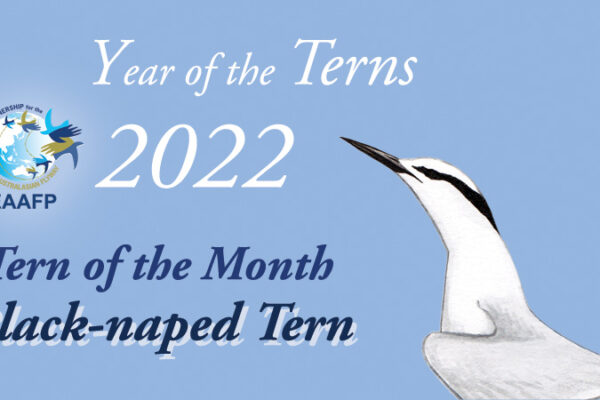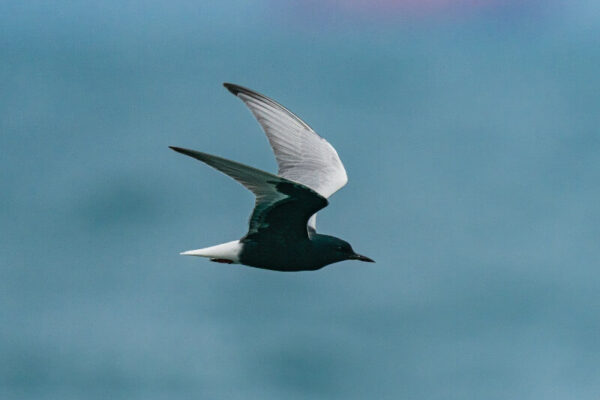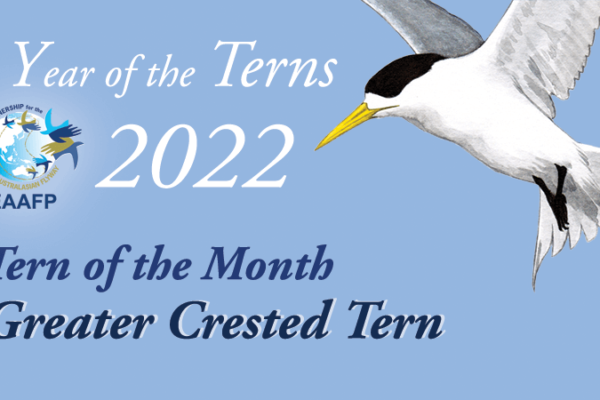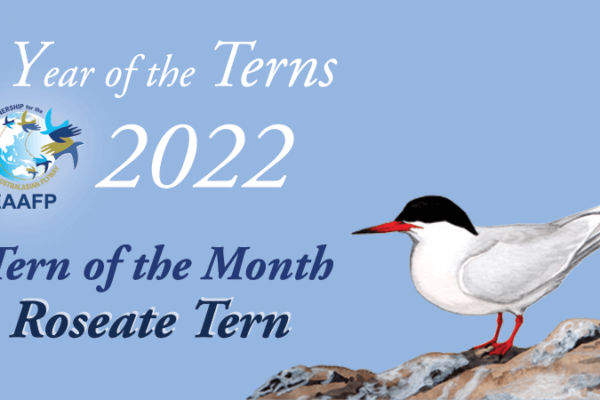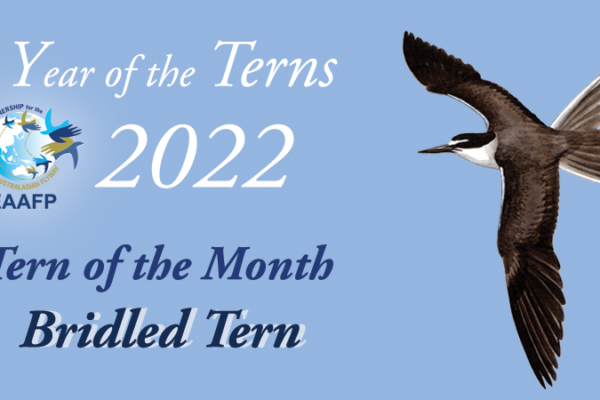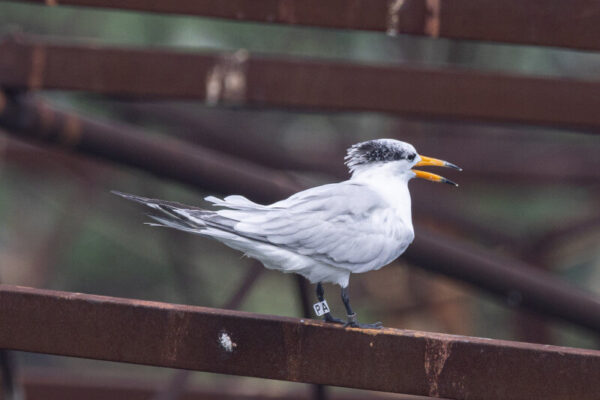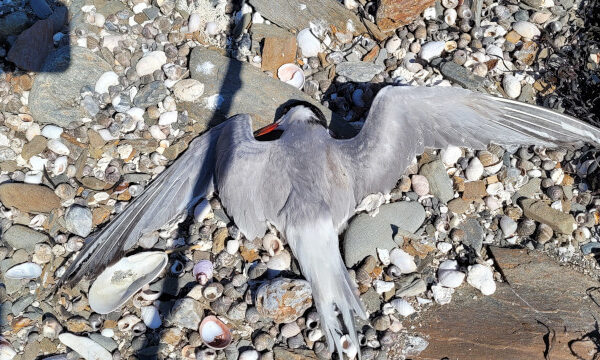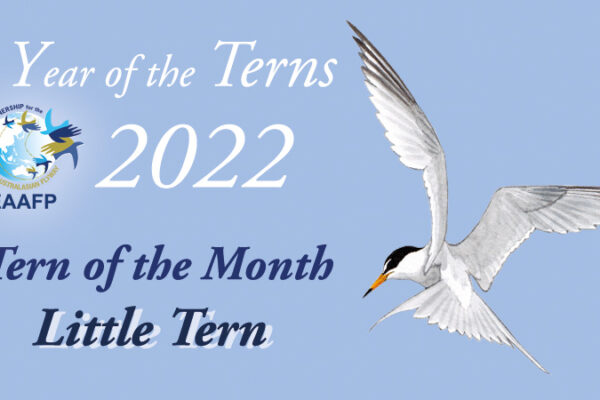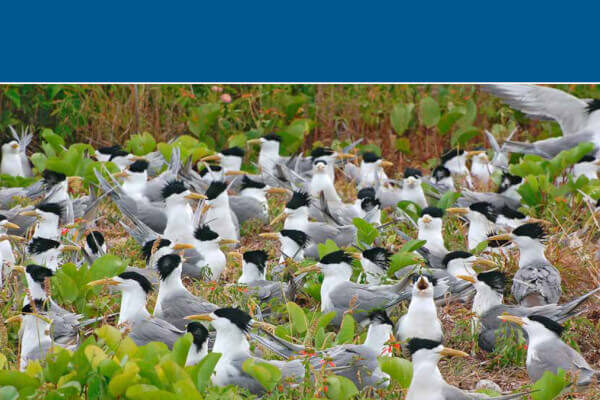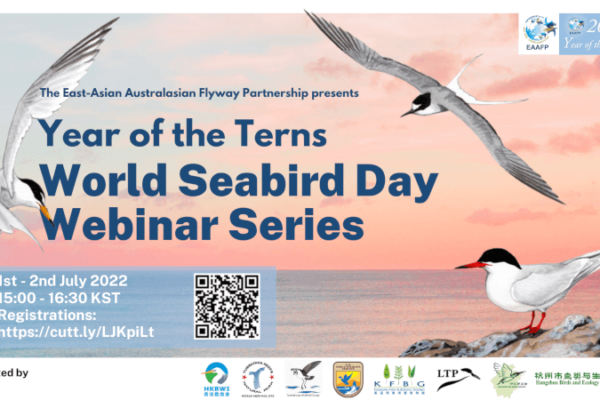-
Black-naped Tern
Black-naped Tern ©Kenneth Lam Common Name: Black-naped Tern Scientific Name: Sterna sumatrana Local names: 黑枕燕鸥 (Simplified Chinese), 黑枕燕鷗 (traditional Chinese), 엘리 그로 제비갈매기 (Korean), エリグロアジサシ(Japanese), Dara laut Tengkuk Hitam (Indonesian), Camar Tengkuk Hitam (Malayu), Nhàn Sumatra (Vietnamese), นกนางนวลแกลบท้ายทอยดำ (Thai). IUCN status: Least Concern The Black-naped Tern is a small to medium-sized tern species, distributed mainly in Tropical Indian and Pacific Oceans. It has distinctive for its white plumage except with a black band from the eyes, which continues in broadening to the nape. It contains two subspecies: S.s. sumatrana and S.s. mathewsi. Identification Adult Black-naped Tern in Hong Kong ©Kenneth Lam Size: 30-35 cm; wingspan 61-66 cm. Breeding plumage: White body a distinctive black band from the eyes, continues in broadening to the nape Non-breeding plumage: Only the black band becomes paler and less defined Juveniles have a dusky cap but leave a white forehead, creating a masked look; upperwings heavily scaled with creamy edges. Beak: black Legs: black Distribution range The subspecies S.s. sumatrana in EAA Flyway region breeds Eastern to Southern Japan, China, then migrate to the south. Others resident or disperse locally in Malaysia, the Philippines, Indonesia and New Guinea, to Northeast and Eastern Australia and Pacific Southwest Pacific Islands. Habitat Breeding habitat Sand or coral islands, reeds, sand spits and rocky cays. Breeding habitat of Black-naped Tern in Hong Kong ©Kenneth Lam Non-breeding habitat Feeds in lagoons and close inshore over breakers, sometimes at sea. Behavior Black-naped Tern feeds on small fish and almost always forages singly by shallow plunge-diving or surface diving. Breeding colonies are small, and usually consist of 5-20 pairs but can be up to 200 pairs. Population estimate The global population has not been quantified. Main threats Human disturbance Invasive non-native/alien species/diseases Natural threats Flooding Conservation Work Conservation research of breeding terns in Hong Kong The Agriculture, Fisheries and Conservation Department (AFCD) of the Hong Kong Government and Hong Kong Bird Watching Society started conservation research on breeding terns in Hong Kong waters in 2018, with support from the Japan Fund for Global Environment (JFGE). The three species of terns breed in Hong Kong are Black-naped, Bridled and Roseate Terns. The flagged terns have the white flag on the right tibia and an engraved yellow flag on the right tarsus (see photo). (Read more: link) A flagged Black-naped Tern in Hong Kong ©Agriculture, Fisheries and Conservation Department (AFCD), HKSAR Fun Fact When facing predators, adults mob predators and may give plover-like “ungulate” displays with upright posture and spread wings to frighten the predators away. References IUCN Red List: https://www.iucnredlist.org/species/22694612/132561758 Birds of the World: https://birdsoftheworld.org/bow/species/blnter1/cur/introduction Seabirds: The New Identification Guideby Peter Harrison, Martin Perrow and Hans Larsson (Lynx Edicions, Barcelona, 2021). Projects on conserving breeding terns in Hong Kong: AFCD: https://www.eaaflyway.net/color-flagging-of-breeding-terns-in-hong-kong-2018/ HKBWS: https://cms.hkbws.org.hk/cms/en/hkbws/work/resarch/tern/tern2019e “Year of the Terns” Flyway Story Series #18 – Interview with Ms. Edin Whitehead Work and achievements of EAAFP Secretariat in collaboration with the Partners in 2022 Webinar on Chinese Crested Tern in the Yellow Sea and Seabird Conservation in China White-winged Tern Greater Crested Tern Winners of 2022 “Year of the Terns” Photo Contest Announced! Roseate Tern Bridled Tern Chinese Crested Tern banded in Republic of Korea sighted in China The Philippines conducts its 1st National Training on Seabird Identification and Monitoring
Continue reading -
White-winged Tern
White-winged tern ©Kenneth Lam Common name: White-winged Tern Scientific name: Chlidonias leucopterus Local names: Белокрылая крачка (Russian), 白翅浮鸥 (Simplified Chinese), 白翅浮鷗 (called in Hong Kong),白翅黑燕鷗(called in Taiwan) (traditional Chinese), 흰죽지제비갈매기 (Korean), ハジロクロハラアジサシ(Japanese), Dara laut sayap putih (Indonesian), Camar Bermisai (Malayu), Nhàn xám (Vietnamese), นกนางนวลแกลบดำปีกขาว(Thai). Also known as White-winged Black Tern. Conservation status: IUCN - Least Concern The White-winged Tern is a Eurasian species. Medium-sized, distinctive in breeding plumage with black head and body while white wing, rump and tail. As the species breeds inland, it adapts to various habitats from freshwater wetlands to coastal wetlands. Identification Size: 23-27 cm; wingspan 58-67 cm. Breeding plumage: Blackhead, body and scapulars Contrasting white and tail and greyish upper wing Non-breeding plumage: Black colour would fade and body become greyish on the body and upper wing Head turned white with dusky crown and ear-coverts patch Juveniles appear like non-breeding adults, but cap, wing and body feathers is blackish-brown, and upper wings are barred and ashy brown. Beak: red to black Legs: Reddish-black Distribution range Breeding range confined to Northern Hemisphere, from Central Europe to Russia reaching to Eastern China. Non-breeding range is towards the southern Hemisphere, including Africa, most of South and Southeast Asia, to New Guinea, Australia and New Zealand. The tern is vagrant to Alaska and elsewhere in the USA. Habitat Breeding habitat Unlike many tern species, White-winged Tern breeds mainly inland, on freshwater lakes and swamps, rivers, and flooded grassland with areas of open water. Non-breeding habitat Non-breeding on migration or winter at various habitats from inland lakes, rivers, flood plains to coastal rocky shores, lagoons and mangrove swamps. The bird is also found feeding over wet fields, farmland and steppe grassland. White-winged Tern roosting at the east coast of Aceh, Indonesia ©Qiran Altafunnisa Behavior White-winged Tern breeds at the age of 2. They breed in small colony from 3-100 pairs, but exhibit low site fidelity. The bird may skip breeding in drought years. Being inland breeders, the bird feed mainly on aquatic insects, sometimes terrestrial insects, and occasionally small fish or tadpoles. Population estimate Global estimated population: The global population is estimated to number c.3,100,000-4,000,000 individuals (Wetlands International 2015). East Asian-Australasian Flyway population is estimated c. 100,000 – 1,000,000 individuals (WPE5). Main threats Habitat destruction Water regulation (increasing drainage schemes) degrades the habitats Other threats Pollution (including plastic pollution) Feral dogs, cats and introduced predators such as raccoons and minks. Susceptible to avian influenza Conservation Work Although it is not highlighted as a specially protected species in any country because of its Least Concern status according to IUCN, it is a species not well-studied. Protection of inland wetland systems and removal of feral and invasive predators (such as dogs, and raccoons) to these sites will benefit its survival. Fun Fact Although breeding mostly in Northern Hemisphere, there were four breeding records in New Zealand from the lower Rakaia River (1917, 3 chicks fledged), Opihi River, South Canterbury (December-February 1973-74), upper Acheron River, Marlborough (December 2012), and near Twizel (January 2015). Its genus name Chlidonias is from Ancient Greek khelidonios, which means "swallow-like". In fact in many countries, terns are referred as ‘sea-swallows’ in local names. Hybridization with Black Tern (Chlidonias niger) has been recorded in Europe. References IUCN Red List: https://www.iucnredlist.org/species/22694730/154676367 Birds of the World: https://birdsoftheworld.org/bow/species/briter1/cur/introduction New Zealand Birds Online: https://nzbirdsonline.org.nz/species/white-winged-black-tern Australian Government Species Profile and Threats Database: https://www.environment.gov.au/cgi-bin/sprat/public/publicspecies.pl?taxon_id=59598 Gochang Big Bird Race 2023 brought birdwatchers to contribute bird data to the UNESCO World Heritage Site Special achievement award to the Chinese Crested Tern team Webinar on Chinese Crested Tern in the Yellow Sea and Seabird Conservation in China Chinese Crested Tern banded in Republic of Korea sighted in China Chinese Crested Tern Restoration of the Critically Endangered Chinese Crested Tern using social attraction technique A Conservation Success in Minjiang River Estuary A tern for the better Critically Endangered Chinese Crested Terns appear on a deserted island in South Korea The First Ever Banded Chinese Crested Tern Chick has Fledged
Continue reading -
Greater Crested Tern
Greater Crested Tern ©Kenneth Lam Common name: Greater Crested Tern Scientific name: Thalasseus bergii Local names:Крачка Берга (Russian), 大凤头燕鸥 (Simplified Chinese), 大鳳頭燕鷗 (traditional Chinese), 큰제비갈매기 (Korean), オオアジサシ(Japanese), Dara laut jambul besar (Indonesian), Camar Besar Berjambul (Malayu), Nhàn mào (Vietnamese), นกนางนวลแกลบหงอนใหญ่ (Thai). Also known as Swift Tern in Africa, and Crested Tern in Australia Conservation status: IUCN - Least Concern The Greater Crested Tern is a large-sized tern species distributed in tropical and subtropical Old World, usually nesting in dense colonies in coastal islands. There are four subspecies recognized: Thalasseus bergii bergii, Thalasseus bergii thalassinus, Thalasseus bergii velox, Thalasseus bergii cristatus, with T.b. cristatus found within the EAA Flyway. Identification Identification: Size: 43–53 cm; wingspan 100–130 cm. Body: Grey upper parts and white under parts. It has a distinctive white forehead, glossy black cap with a long crest, crest recedes in the non-breeding season Beak: Yellow Juvenile: Juveniles appear like non-breeding adults, with crown feathers brownish with pale spots, underparts and upper wings are barred and ashy brown. Distribution range Thalasseus bergii cristatus: Northern-most breeding range in Ryukyu Islands and southeastern China up to the Yangtze Estuary, all-year-round to the Philippines, Southeast Asia, the Sunda Islands, Wallacea, New Guinea, Australia, and the tropical Pacific Ocean (to southeastern Polynesia). Non-breeding movement is understudied. Satellite tracking showed those breeding in SE China winter in coastal Indo-China, Thailand, Myanmar and northern Philippines. Birds breeding at Paracel (Xisha) Islands in the South China Sea winter in central Philippines and Borneo. Non-breeding birds in Wallacea were mostly tracked to visit northern Australia where they may breed, with one tracked to Palau. Habitat Breeding habitat Nests on offshore islands, low-lying sandy, rocky or coral islets, usually unsheltered bare surface. The bird forages in shallow waters in estuaries, lagoons and barrier reefs, along beaches, and also in the open sea. They may take rest on buoys or sandbars. Breeding habitat of Greater Crested Tern in Zhejiang, China © Simba Chan Dense nesting colony of Greater Crested Tern in Zhejiang, China © Simba Chan Non-breeding habitat Greater Crested Tern wanders and disperses after the breeding season. They use sandy islands, coastal sandy or tidal flats. Greater Crested Tern resting on buoy ©Kenneth Lam Behavior Greater Crested Tern nest in dense breeding colonies, also highly vocal during breeding season. Colony size is depending on food abundance and habitat area. Largest colony can be up to 15,000 pairs. Although the bird nest in dense colony, but each pair establish small area of territory and they would peck any intruder bird in the territory. The male bird would perform courtship dance for female, with nuptial gifts, usually fish. Population estimate Global estimated population: The global population is estimated to number c.150,000-1,100,000. while regional population estimates in EAA Flyway are 100,000-1,000,000 according to the 1st Conservation Status Review. However, the estimation seemed to lump several populations together. From present knowledge the Greater Crested Tern breeding along the coasts of Zhejiang, Fujian, Taiwan and Guangdong are likely belonged to one population that migrates to Indo-china, Thailand, Myanmar and the northern Philippines. This population is probably around 30,000 birds with an increasing trend. Main threats Human disturbance, e.g. recreational and tourism activities in coastal areas close to breeding colonies Egg collection Habitat loss (Note: A regular migratory stop-over site for this species and many other terns and shorebirds, the tidal flat of Pamawaran, Bulacan in Manila Bay, the Philippines, is currently under threats from reclamation for airport expansion. Hundreds of Greater Crested Terns, including up to 10 individuals color-banded from Zhejiang and Taiwan, have been recorded at these sites since 2021.) GCT color-banded in Zhejiang, China sighed at Manila Bay, the Philippines on 28 October 2022 © Irene Dy Other threats: Pollution Plastic pollution Over-fishing Natural threats: Adverse weather conditions, e.g. typhoons, heavy rains, strong winds and waves Natural predators (e.g. gulls, Peregrine Falcon, snakes, rats) Conservation Work Satellite tracking study of Greater Crested Terns in collaboration with Indonesia shed light to conservation of Criticallty Endangered Chinese Crested Tern wintering ground Greater Crested Terns provide socia protection to the critically endangered Chinese Crested Terns in both breeding and wintering grounds. Studying both or either one species could provide useful information for the conservation of both crested terns. HKBWS in collaboration with partners in Indonesia conducts satellite-tracking studies of the Greater Crested Terns in Wallacea region of Indonesia since 2018. Previously we assumed the Greater Crested Terns in this area could have a northern breeding origin, through the tracking study we could find out migration routes and stopover sites of Greater Crested Tern and potentially to the Chinese Crested Terns too. The results brought us unexpected findings that birds in Wallacea region migrated south to the Gulf of Carpenteria of northern Australia for breeding and one bird migrated to Palau. These birds stayed in the areas where are the known tern breeding sites. Non-adults did not migrate to these breeding areas but wandered around Banda Sea, Timor Sea and Arafura Sea. Migration route and hotspots are now being identified with this study as site and habitat management could now be considered to apply in the important sites. This finding can also help promoting seabird conservation collaboration between Indonesia, Australia and other neighouring countries. Mr. Yu Yat Tung, Research Manager of HKBWS released a Greater Crested Tern fitted with a satellite transmitter in the wintering island of Indonesia © HKBWS Greater Crested Tern fitted with satellite transmitter in Indonesia © Simba Chan Learn more: https://www.hkbws.org.hk/cms/en/hkbws/cct2019 Tubbataha Reefs Natural Park holds the largest breeding colony of Greater Crested Terns in the Philippines with at least 14,000 individuals as of the last survey. They breed in the two islets of Tubbataha. These breeding grounds are off limits to tourists to prevent stress and disturbance especially during the breeding months of March to July. Marine park rangers conduct monthly estimates of adults and a more comprehensive quarterly inventory which includes eggs, pulli, and juveniles. The Philippine Red List of Threatened Fauna classifies the Greater Crested Terns as Vulnerable. Tubbataha Reefs Natural Park ©Godfrey Jacosalem Tubbataha Reefs Natural Park ©Kymry Delijero Fun Fact Although Greater Crested Tern is among one of the biggest terns, it is a very nerous breeder. They tend to form very big and dense nesting colonies thus easy to be found during breeding season. Because the critically endangered Chinese Crested Terns nest in the same colony amid Greater Crested Terns in Zhejiang, Fujian and Taiwan, attracting Greater Crested Tern to breed in desired protected site supported restoring the population of Chinese Crester Tern. Hybridization is reported but the threat is much lower than commonly believed as they have a very strong sense of species identify. Hybrid birds (which may be the result of wrong imprinting) are very difficult to find a mate (pers. obs.). Chinese Crested Tern is a close relative to Greater Crested Tern, so close that the type specimen of Chinese Crested Tern collected near Halmahera, Indinesia in 1861 was long regarded as a Greater Crested Tern (corrected since 1975), and a specimen of Chinese Crested Tern collected near Chemulpo (now Incheon), Korea in 1917 was also misidentified as a Greater Crested Tern (corrected since 2016). References IUCN Red List: https://www.iucnredlist.org/species/22694571/132561035 Birds of the World: https://birdsoftheworld.org/bow/species/grcter1/cur/introduction Gochang Big Bird Race 2023 brought birdwatchers to contribute bird data to the UNESCO World Heritage Site Special achievement award to the Chinese Crested Tern team Webinar on Chinese Crested Tern in the Yellow Sea and Seabird Conservation in China Chinese Crested Tern banded in Republic of Korea sighted in China Chinese Crested Tern Restoration of the Critically Endangered Chinese Crested Tern using social attraction technique A Conservation Success in Minjiang River Estuary A tern for the better Critically Endangered Chinese Crested Terns appear on a deserted island in South Korea The First Ever Banded Chinese Crested Tern Chick has Fledged
Continue reading -
Roseate Tern
Roseate Tern ©Kenneth Lam Common name: Roseate Tern Scientific name: Sterna dougallii Local names:Розовая крачка (Russian), 粉红燕鸥 (Simplified Chinese), 粉紅燕鷗 (traditional Chinese), 긴꼬리제비갈매기 (Korean), ベニアジサシ(Japanese), Dara laut Dougalli (Indonesian), Camar Jambu (Malayu), Nhàn hồng (Vietnamese), นกนางนวลแกลบสีกุหลาบ (Thai) Conservation status: IUCN - Least Concern Roseate Tern is primarily distributed in tropical and subtropical seas. It is a strictly marine species. It is a specialized plunge-diver, feeding on small schooling fishes. There are three subspecies: S. d. dougallii, S. d. gracilis, S. d. korustes. Identification Adult Roseate Tern ©Kenneth Lam Size: 33-41 cm; wingspan 72–80 cm. Body: medium-sized, very white-looking, with long tail-streamers. In breeding season, adults have a pinkish tinge to their underparts which gives them their name. Head: has a black cap which goes to the front of the base of the beak Beak: black beak with reddish base Legs and feet: reffish during breeding season, blackish in non-breeding season Juvenile: gray or buff above with some intermediates, barred with black chevrons The Roseate Tern is similar to the Common, Arctic and Forster's Terns, as they are medium-sized and grouped to ‘typical black-capped terns' of the genus Sterna. Distribution range Roseate Tern is widespread but breeding colonies sparely distributed along the east coast and offshore islands of Canada, U.S.A. down to Venezuela and Brazil, Caribbean, UK. France, Ireland, Portugal to Africa. In EAA Flyway, it breeds in South China Sea, Ryukyu Islands (Japan), Indonesia, Fiji, Solomon Islands, Papua New Guinea, and along coast of Australia. Wintering range is understudied. Habitat Breeding habitat The bird breeds on sandy, rocky or coral islands, with dense vegetation in temperate region, but mainly on barren islets in tropics. They primarily migrate offshore. Roseate Tern at breeding site ©Kenneth Lam Non-breeding habitat Little information but the bird is exclusively marine. Study with immersion sensors suggested they rest on water during daytime, indicating that they are feeding at sea and not resting on land between feeding bouts, but they rest on land during night time. Behavior Roseate Tern are diurnal species. They use aerial plunge-diving to catch food, often submerge briefly in water. At breeding colonies, frequently found at mixed colonies with other tern species, such as Black-naped Tern and Bridled Tern in South China and Southeast Asia waters. It spends much time bathing in shallow water close to shore. Population estimate Global estimated population: The global population is estimated to number c. 400,000-1,000,000 individuals. Its population in the EAAF is c. 90,000 base on estimation of population of S.d. gracilis, Australia & Moluccas Is. Main threats Human disturbance, e.g. recreational and tourism activities at breeding sites Egg collection and chicks harvest Other threats: Plastic pollution Exotic predators Conservation Work Banding studies in Japan and Australia Roseate Tern at breeding site in Japan © Kiyoaki Ozaki/Yamashina Institute for Ornithology Roseate Tern at banded with engraved blue legflag in Japan © Kiyoaki Ozaki/Yamashina Institute for Ornithology Roseate Tern’s main breeding sites in Japan are in the Ryukyu Islands but in recent years some birds bred further north in Fukuoka, Osaka and Aichi. Banding of the terns has been started since 1975. A total of 11,981 birds were banded until 2020 and 391 Roseate Tern were recovered, which revealed their wintering site is in Swains Reef, Queensland Australia. Projects in Australia captured 368 Roseate Terns in July, 1999, 2000 and 2001, and 3044 in January of 2002 and 2003 in Swain Reefs. The study determined that at least some Roseate Terns bred on the Capricornia Cays in Australia. And it was the first evidence that Asian-breeding Roseate Terns over-winter in the southern hemisphere. Learn about the Japan bird banding report in 2020: https://www.biodic.go.jp/banding/pdf/banding_2020.pdf Fun Fact In 2002, the Japan Bird Migration Research Center compiled longevity records of Japanese birds based on research during 1961‒1995. From the reports with data collected during 1961‒2017, Roseate Tern holds a 23 years 11months record, the longest lifespan known so far. Reference IUCN Red List: https://www.iucnredlist.org/species/22694601/132260491 Birds of the World: https://birdsoftheworld.org/bow/species/roster/cur/introduction Research papers: O’Neill Paul, Minton Clive, Ozaki Kiyoaki, White Rebecca (2005) Three populations of non-breeding Roseate Terns (Sterna dougallii) in the Swain Reefs, Southern Great Barrier Reef, Australia. Emu 105, 57-66. (https://doi.org/10.1071/MU03044) Yoshiyasu K, Morimoto G, Senda M, Nakamura N (2020) Longevity records of Japanese birds from bird banding data (top two records of each species in 1961–2017). J Yamashina Inst Ornithol. https://doi.org/10.3312/jyio.52.21 Gochang Big Bird Race 2023 brought birdwatchers to contribute bird data to the UNESCO World Heritage Site Special achievement award to the Chinese Crested Tern team Webinar on Chinese Crested Tern in the Yellow Sea and Seabird Conservation in China Chinese Crested Tern banded in Republic of Korea sighted in China Chinese Crested Tern Restoration of the Critically Endangered Chinese Crested Tern using social attraction technique A Conservation Success in Minjiang River Estuary A tern for the better Critically Endangered Chinese Crested Terns appear on a deserted island in South Korea The First Ever Banded Chinese Crested Tern Chick has Fledged
Continue reading -
Bridled Tern
Bridled Tern ©Kenneth Lam Common name: Bridled Tern Scientific name: Onychoprion anaethetus Local names: Бурокрылая крачка(Russian), 褐翅燕鸥 (Simplified Chinese), 褐翅燕鷗 (traditional Chinese), 에위니아제비갈매기 (Korean), マミジロアジサシ(Japanese), Dara laut kendal (Indonesian), Camar Batu (Malayu), Nhàn lưng nâu (Vietnamese), นกนางนวลแกลบคิ้วขาว(Thai) Conservation status: IUCN - Least Concern Bridled Tern is a widespread seabird found in warm oceans around the world. They are fairly common in the tropical seas. It is a strictly marine species but is often found in offshore waters instead of open oceans. Identification Identification: Adult Bridled Tern ©Kenneth Lam Immature Bridled Tern ©Kenneth Lam Size: 30–32 cm; wingspan 77–81 cm. Body: medium-sized, with long and narrow wings as well as long and deeply forked tail with white. Wings, back and tail brownish-grey color. Underwing and body white color. Head: black cap with white forehead and a white stripe above the eyes. White chin and beck Beak: black and as long as the head Legs and feet: blackish Juvenile: coloration is similar but duller than adults, but with some scaling and streaking to the upperparts A similar species to Bridled Tern is Sooty tern as general plumage color of upper surface, but could be distinguished by its larger size (33 -36 cm; wingspan 82 -94 cm) and head pattern, which the latter has less of the white forehead and lack white stripe running above and extending after the eyes. Distribution range The breeding range is widespread, mainly in subtropical and tropical west Pacific, Atlantic, and Indian Oceans. In EAA Flyway, It breeds on the west coast of Thailand, east Gulf of Thailand, Malaysia, and south to Indonesia and Australia, towards the west to north of Philippines and islands off Southeast China. Its known northernmost breeding sites are Zhongjieshan Islands of Zhejiang, and Toku-no-jima of Kagoshima Prefecture, Japan. Wintering range is understudied but basically in oceans of their breeding grounds. Birds breeding in China were found wintering at the Gulf of Thailand, Natuna Sea, Sulu Sea and Makassar Strait in Southeast Asia. Habitat Breeding habitat Bridled Tern breeds on offshore rocky islands of limestone and volcanic stacks, vegetated coral cays and exposed reefs. Also found breeding on slopes of sandy dunes, under low vegetation and cliff-holes in some colonies. Breeding habitat of Bridled Tern ©Kenneth Lam Non-breeding habitat Entirely aerial and marine during non-breeding season. Bridled Tern at non-breeding period, resting on flotsam ©Kenneth Lam Behavior Bridled Terns showed an uncommon breeding pattern, in some populations, they has synchronous, subannual breeding cycles (breeding interval is less than one year) that coincide with molt. Some breeding pairs maintain with the same partners over successive seasons. Breeding space is highly dispersed and unevenly. Typically laying 1 egg per clutch. They are frequently found at mixed colonies with Black-naped Terns and Roseate Terns in South China and Southeast Asia waters. Population estimate Global estimated population: The global population is estimated to number c. 400,000-1,000,000 individuals. Its population in the EAAF is not yet estimated but it is one of the most common coastal breeding terns in tropical and sub-tropical Asia. Main threats Human disturbance, e.g. recreational and tourism activities at breeding site trigger nest abandoned Egg collection and chicks harvest Other threats: Pesticides and Other Contaminants/Toxics, e.g. oil spills risk Plastic pollution Exotic predators Conservation Work Hong Kong has started tracked study of breeding tern species. In 2017, the Agriculture, Fisheries and Conservation Department (AFCD), Hong Kong SAR Government attached color flags to 19 adult and juvenile Bridled Terns in August 2017. In 2018, Hong Kong Bird Watching Society (HKBWS, EAAFP Partner) started conservation research on breeding terns in Hong Kong waters, with support from the Japan Fund for Global Environment (JFGE). HKBWS deployed marking with rings and coloured flags on a total of 110 adult and juvenile Bridled Terns trapped during breeding season in 2019m including two individuals fitted with satellite-tracking transmitters. (Note: speciall permit issued by AFCD, HKSAR) Tracking study of Bridled Tern ©HKBWS Fun Fact The specific name of Bridled Tern, anaethetus, is derived from a Greek root meaning senseless or stupid, a reference to its tameness and ease of capture by hungry sailors. One Bridled Tern found injured (and later died) at Nago City, Okinawa, Japan on 13 October 2014 was found to be banded in Persian Gulf in Iran (as chick) on 28 July 2013. The bird travelled more than 7,450 km (linear distance) and was the first Iranian banded bird recovered in Japan (link). References IUCN Red List: https://www.iucnredlist.org/species/22694730/154676367 Birds of the World: https://birdsoftheworld.org/bow/species/briter1/cur/introduction Projects on terns in Hong Kong: AFCD: https://www.eaaflyway.net/bridled-terns-onychoprion-anaethetus-ringed-in-hong-kong/ HKBWS: https://cms.hkbws.org.hk/cms/en/hkbws/work/resarch/tern/tern2019e Gochang Big Bird Race 2023 brought birdwatchers to contribute bird data to the UNESCO World Heritage Site Special achievement award to the Chinese Crested Tern team Webinar on Chinese Crested Tern in the Yellow Sea and Seabird Conservation in China Chinese Crested Tern banded in Republic of Korea sighted in China Chinese Crested Tern Restoration of the Critically Endangered Chinese Crested Tern using social attraction technique A Conservation Success in Minjiang River Estuary A tern for the better Critically Endangered Chinese Crested Terns appear on a deserted island in South Korea The First Ever Banded Chinese Crested Tern Chick has Fledged
Continue reading -
Chinese Crested Tern banded in Republic of Korea sighted in China
The connection between RoK-breeding Critically Endangered Chinese Crested Tern and…
Continue reading -
Little Tern
Little Tern ©Kenneth Lam Common name:Little Tern Scientific name: Sternula albifrons Local names: Малая крачка(Russian), Хурган хараалай(Mongolian), 白额燕鸥 (Simplified Chinese), 白額燕鷗/小燕鷗 (traditional Chinese), 쇠제비갈매기 (Korean), コアジサシ(Japanese), Dara laut kecil (Indonesian), Camar Kecil (Malayu), Nhàn nhỏ (Vietnamese), นกนางนวลแกลบเล็ก (Thai). Conservation status: IUCN - Least Concern The Little Tern is one of the smallest tern species in EAA Flyway. It has wide distribution range across the East Asian-Australasian Flyway and the East Atlantic Flyway. Five subspecies recognized: Sternula albifrons albifrons; Sternula albifrons innominate; Sternula albifrons guineae; Sternula albifrons sinensis and Sternula albifrons placens, with the later two subspecies S. a. sinensis and S. a. placens found within the EAA Flyway. Identification Size: 22–28 cm; wingspan 47–55 cm. Body: slender light grey wings and body, with a white rump, tail long and forked Breeding plumage Head: distinctive white forehead, black cap and lores. Beak: bright yellow beak with a small black tip Orange-yellow legs Non-breeding Plumage Head: forehead is more predominantly white Beak: blackish beak Dull orange to blackish legs Juveniles appear like the non-breeding adults, except for a narrower black rear crown, and a more brownish-white forehead and crown. They have a U-shaped marking which is visible on the shoulders Little Terns can be confused with Fairy Terns (Sternula neresis), Saunder's Terns (Sternula saundersi), Least Terns (Sternula antillarum), Yellow-billed Terns (Sternula superciliaris), and Peruvian Terns (Sternula lorata). Distribution range Sternula albifrons sinensis: Palaearctic breeders in southeastern Siberia, Korea Penisular, Japan and China migrate south in the non-breeding season, mainly in the tropical region, but could reach down to New Guinea and Australia. Some are also found all year round in northern India and Sri Lanka east to southeastern Asia, the Philippines, and northern Australia. Sternula albifrons placens: East Australia and East Tasmania Habitat Breeding habitat Little Tern breeds on sand spits, banks, ridges or islets, and sandy beaches in coastal environments including coastal lakes, estuaries and inlets. The nest is a shallow scrape positioned on the ground above the high tide-line and often only a few meters away from shallow clear water where it lays one to three eggs a clutch. Breeding habitat of Little Tern © Yutaka Otsuka Non-breeding habitat Coastal tidal creeks, lagoons and saltpans; sometimes feed in the open sea. Non-breeding site in Singapore ©Kenneth Lam Behavior Little Terns is a ground-nesting bird and it nests in small loose colonies., with the distance between nests usually more than 2m. Breeding colonies are small to medium-sized, up to 40 pairs, seldom > 100 pairs. Little Tern shows moderately high site fidelity. Courtship occurs by presenting and feeding the females with fish and may last from a few days to weeks. Population estimate The global population is estimated to number c.190,000-410,000 individuals. There is no accurate census date for subspecies S.a. sinensis but estimated to 10,000 – 100,000 birds, while S. a. placens is estimated to have 10,000 birds. Main threats Habitat loss by reclamation Human disturbance, e.g. recreational and tourism activities at coastal areas close to breeding colonies Stray or feral dogs and cats at breeding sites. Other threats: Pollution Egg collection Artificially-induced water-level fluctuation Sand-mining Natural threats: Flooding Adverse weather conditions, e.g. typhoons, heavy rains, strong winds and waves Natural predators (e.g. Peregrine Falcon, snakes, rats) Conservation Work Artificial breeding habitat on building rooftop in Tokyo, Japan to restore Little Tern breeding colony Since 2001, a new NGO Little Tern Project has been established to manage the initiative of building artificial breeding habitats on the rooftop of buildings in Tokyo Bay, Japan. This sustained over 2000 nests, although the population fluctuate due to various factors. The project also integrates with local community engagement and citizen science. Conservation of Little Tern is also part of local policy, e.g. Basic Environmental Plan of Ota City. Learn more: https://littletern.net/ Little Tern breeding at Morigasaki Water Reclamation Center of Tokyo © Little Tern Project Tracking and studies on migratory routes of Little Tern There are independent or internationally collaborative banding and tracking projects on Little Tern. Banding and colour-marking have been done in Australia by New South Wales (NSW) National Park and Wildlife Services (2003). In Japan, Yamashina Institute of Ornithology, Japanese Society for Preservation of Birds and Little Tern Project had banding and banding programme, and utilize of geo-locators. Japan had a collaborative project with Australia between 2012-2015 (link). In Guangdong, China, a joint research carried out by Little Tern Project, Hong Kong Bird Watching Society, Guangdong Haifeng Bird Provincial Nature Reserve Office, and Sun Yat-sen University has done colour-marking on Little Terns in 2017 and 2018. A yellow ring with a white engraving of A and 2 numerals had been placed on the right tarsus, as shown in the photo below (Yu, pers. comms.). However, further surveys in 2018 could not find any colour-marked Little Tern at this site. A Little Tern with geolocator ©Eugene Cheah Little Tern Recovery Plan in New South Wales, Australia The Little Tern is listed as Endangered in New South Wales of Australia under the Threatened Species Conservation Act 1995 (TSC Act). This Recovery Plan was launched in 2003, which constitutes the approved NSW State Recovery Plan for the Little Tern. It covers conservation requirements of the species across and identifies conservation actions to be undertaken to ensure the long-term survivorship of the species. Learn more: link © New South Wales Government Fun Fact A Little Tern in Australia had been recorded to reach 17 years old. Generally, Little Terns start breeding from 3 years old, occasionally at 2 years old. Regarding species looks similar to the Little Tern, while Fairy Tern might turn up in Indonesia and Saunders’s Tern in western SE Asia, Yellow-billed Tern and Peruvian Tern are highly unlikely to be found in EAAF countries. The most frequent confusion is with the Least Tern. It is an uncommon but regular visitor to Japan (first confirmed record was a banded bird from North Dekota, USA recovered at the coast of Ibaraki Prefecture, Japan in July 2014) and probably can occasionally be found in eastern Asia. References IUCN Red List: https://www.iucnredlist.org/species/22694656/155476219 Birds of the World: https://birdsoftheworld.org/bow/species/litter1/cur/introduction Gochang Big Bird Race 2023 brought birdwatchers to contribute bird data to the UNESCO World Heritage Site Special achievement award to the Chinese Crested Tern team Webinar on Chinese Crested Tern in the Yellow Sea and Seabird Conservation in China Chinese Crested Tern banded in Republic of Korea sighted in China Chinese Crested Tern Restoration of the Critically Endangered Chinese Crested Tern using social attraction technique A Conservation Success in Minjiang River Estuary A tern for the better Critically Endangered Chinese Crested Terns appear on a deserted island in South Korea The First Ever Banded Chinese Crested Tern Chick has Fledged
Continue reading -
Australia’s Wildlife Conservation Plan for Seabirds
At the national level in Australia, the Environment Protection and Biodiversity Act 1999 (EPBC Act) provides for the development and…
Continue reading -
“Year of the Terns” World Seabird Day Webinar Series
“Year of the Terns” World Seabird Day Webinar Series Brief Introduction To raise awareness among EAAFP Partners, researchers, conservationists, and the general public about seabirds in the East Asian – Australasian Flyway (EAA Flyway), while promoting the exchange of information and collaboration on seabird conservation in the Flyway, the EAAFP Secretariat and the Seabird Working Group initiated the “Year of the Terns” in 2022. The World Seabird Day Webinar Series is one of the campaign activities for “Year of the Terns.” With the aim of showcasing and raising awareness for seabird conservation work along the EAA Flyway, the webinar series consist of two sessions, to launch the Asia Seabird Colony Registry, as well as showcasing work on tern species and their conservation. Date/Time: 1 – 2 July 2022 (15:00 – 16:30 KST on both dates) Topics: Session 1 (1 July): Launch of the Asia Seabird Colony Registry Session 2 (2 July): Showcase of tern conservation projects in EAA Flyway Organizers: EAAFP Secretariat, EAAFP Seabird Working Group, Australasian Seabird Group, Hong Kong Bird Watching Society, Tubbataha Reefs Natural Park. Meeting Platform: Zoom Language: English Registration: https://us02web.zoom.us/meeting/register/tZ0rce6prD8iGtax5wFiPEf6GfTOomM8A58c (https://cutt.ly/LJKpiLt) Overall Programme Day Programme Speakers Day 1 Welcoming Speech Doug Watkins, Chief Executive of EAAFP Secretariat Robert Kaler, Chair of EAAFP Seabird Working Group Presentation on Year of the Terns Vivian Fu, EAAFP Communication Officer Introduction of World Seabird Registry Robert Kaler, Chair of EAAFP Seabird Working Group Presentation on the launch of the Seabird Breeding Registry in EAAF Simba Chan, Seabird Working Group Panel Discussion Moderated by Yat Tung Yu, Coordinator of EAAFP Seabird Working Group Panelists: Simba Chan, Angelique Songco, Site Manager of Tubbataha Reefs Natural Park, Philippines, Miran Kim, Seabirds Laboratory of Korea, Republic of Korea Nicholas Carlile, Australasian Seabird Group Day 2 Welcoming Speech Yat-tung Yu, Coordinator of EAAFP Seabird Working Group Primer screening of “Terns Operation” about Chinese Crested Tern, by Fung Hong Shing 1. Presentation on Aleutian Tern Robert Kaler, EAAFP Seabird Working Group Chair 2. Presentation on Little Tern Professor Wataru Kitamura, Tokyo City University 3. Presentation on Chinese Crested Tern Siyu Wang, Zhejiang Natural History Museum 4. Presentation on Terns breeding in Hong Kong John Chung, Hong Kong Bird Watching Society 5. Presentation on River Tern Zheng Xi, Kadoorie Farm and Botanic Garden – Hong Kong 6. Presentation on Black Noddy Retch Pagliawan-Alaba, Research Officer, Tubbataha Reefs Natural Park 7. Presentation on White Tern Nicholas Carlile, Australasian Seabird Group Q&A Moderated by Yuna Kim, Australasian Seabird Group Webinar Speakers and Moderators: Day 1 “Launch of the Asia Seabird Colony Registry” Date: 1st July 2022 (15:00 – 16:30 KST) Registration Link: https://us02web.zoom.us/meeting/register/tZ0rce6prD8iGtax5wFiPEf6GfTOomM8A58c Key speaker Simba Chan Seabird Working Group Panelists Angelique Songco Site Manager, Tubbataha Reefs Natural Park, the Philippines Angelique Songco has more than 20 years of experience as a site manager of Tubbataha Reefs Natural Park, an UNESCO World Heritage Site and Flyway Network Site. Referred to as “Mama Ranger,” Angelique is also a member of the EAAFP Seabird Working group and works on the frontier in safeguarding important sites. Miran Kim Seabirds Laboratory of Korea Miran Kim is working in the Seabirds Lab of Korea. During her PhD, she studied egg morphology and hatching asynchrony in gulls. She has worked for the conservation of Swinhoe’s storm petrels and long-term monitoring of Black-tailed gulls. Recently, she is investigating the impacts of marine debris and bycatch on seabirds. Nicholas Carlile Australasian Seabird Group Nicholas commenced ecological research with the Australian Museum 1986 and since 1988 with the NSW States government. His work includes island biodiversity restorations and surveys, research into seabirds and their translocation. While focusing mainly on petrels, he has researched Little, Sooty and White terns as well as Boobies and Tropicbirds. Moderators Vivian Fu Communication Officer, EAAFP Secretariat Yat Tung Yu Director, Hong Kong Bird Watching Society Coordinator, Seabird Working Group Day 2: “Showcase of Tern Conservation Projects in the EAA Flyway “ Date: 2nd July 2022 (15:00 – 16:30 KST) Registration Link: https://us02web.zoom.us/meeting/register/tZ0rce6prD8iGtax5wFiPEf6GfTOomM8A58c Speakers Robert Kaler Chair, Seabird Working Group Robb Kaler is a biologist with the U.S. Fish and Wildlife Service in Alaska, USA. Robb serves as chair of the EAAFP Seabird Working Group is interested in developing collaborations towards broad conservation goals that inform management decisions and promote seabird conservation. Professor Wataru Kitamura Associate Professor, Tokyo City University Wataru Kitamura Ph.D. is an associate professor at Tokyo City University and the president of NPO Little Tern Project aiming for conservation of the Little Terns on a rooftop in Tokyo. His main research area is conservation biology of avian species such as giving solutions for bird collisions to wind turbines and interaction between alien and native species. Siyu Wang Research Associate, Zhejiang Museum of Natural History Siyu Wang, research associate of Zhejiang Museum of Natural History, now mainly working on Chinese Crested Tern and Scarly-sided Merganser conservation. Since 2014, I participates in the Chinese Crested Tern Project as a team member. Except from research work, I'm also responsible for Science Popularization of Chinese Crested Tern and other birds. John Chung Hong Kong Bird Watching Society After graduating from the Chinese University of Hong Kong with an MPhil degree, John Chung devotes himself to bird research and conservation. He is currently a research officer in the Hong Kong Bird Watching Society. He is responsible for coordinating bird ringing, tern study, and citizen science programs in Hong Kong. Zheng Xi Kadoorie Farm and Botanic Garden - Hong Kong Zheng Xi is a Conservation Officer of Kadoorie Farm & Botanic Garden. He has been actively involved in several key conservation projects to minimize biodiversity loss in China and Cambodia, including the conservation of River Tern and Hornbills in western Yunnan of China. Retch Pagliawan-Alaba Research Officer, Tubbataha Reefs Natural Park Retch is the Research Officer of the Tubbataha Reefs Natural Park in the Philippines. She began working on seabirds in 2013 as part of her MSc studies. One of their seabird conservation projects is the restoration of the Black Noddy population in TRNP. Nicholas Carlile Australasian Seabird Group Nicholas commenced ecological research with the Australian Museum 1986 and since 1988 with the NSW States government. His work includes island biodiversity restorations and surveys, research into seabirds and their translocation. While focusing mainly on petrels, he has researched Little, Sooty and White terns as well as Boobies and Tropicbirds. Moderators: Yat Tung Yu Director, Hong Kong Bird Watching Society Coordinator, Seabird Working Group Yuna Kim Australasian Seabird Group Supporting Organizations Playback of the Webinar Day 1 Launch of the Asia Seabird Colony Registry Day 2 Showcase of conservation work of terns EAAF Contact If you have any inquiries, please feel free to contact Mr. Yat-tung Yu, Coordinator of the Seabird Working Group at yyattung@hkbws.org.hk; or Ms. Vivian Fu, Communication Officer of EAAFP at communication@eaaflyway.net.
Continue reading

